Shopping
& Souvenirs Available in Nepal

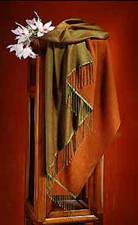 The
craftsmen of the Kathmandu Valley were well respected at the royal
court of China in ancient times. The very same crafts which earned
them fame are practiced here today, side by side with their modern
brothers and sisters. To step into a Kathmandu Valley workshop is
to step back in time 400 years. And those items which you bring
home with you will forever link you to the days of exotic courts
and arduous trade routes. The
craftsmen of the Kathmandu Valley were well respected at the royal
court of China in ancient times. The very same crafts which earned
them fame are practiced here today, side by side with their modern
brothers and sisters. To step into a Kathmandu Valley workshop is
to step back in time 400 years. And those items which you bring
home with you will forever link you to the days of exotic courts
and arduous trade routes.
Garments. Handmade garments like
shawls, woolen sweaters, jackets, trousers and caps are very functional
as well as interesting articles to take back home.
If you're looking for customed tailor business
attire, Nepal can deliver copies of the highest quality brand names
for a fraction of the price. See VisitNepal.com Sponsor Shrestha
Tailoring to get a glimpse of one of the industry leaders
- they even offer free shuttle service from your hotel to one of
their showrooms and tailor shops.
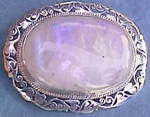 Gems.
Kathmandu boasts one of the widest selections of loose gems in the
entire region, often at comparatively low prices. Many stones including
ruby, aquamarine, black and green tourmaline, quartz and "healing
stones" are mined in the high mountains of Nepal. Want to know
what stone is best for you? Diana, of Nepal's
Energy Information Center, certainly knows. She lives
in Chiangmai, Thailand these days. Communicate or pay her a visit
in Chiangmai. You will surely be surprised to find out what else
she has to say. Gems.
Kathmandu boasts one of the widest selections of loose gems in the
entire region, often at comparatively low prices. Many stones including
ruby, aquamarine, black and green tourmaline, quartz and "healing
stones" are mined in the high mountains of Nepal. Want to know
what stone is best for you? Diana, of Nepal's
Energy Information Center, certainly knows. She lives
in Chiangmai, Thailand these days. Communicate or pay her a visit
in Chiangmai. You will surely be surprised to find out what else
she has to say.
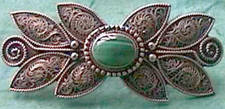 Jewelry.
Apart from necklaces, bracelets, rings and the traditional silver
beads made especially in Patan, old Tibetan jewelry also abounds
in the markets of Kathmandu. A glass bead market tucked away near
Indra Chowk stocks colorful glass beads imported from all over the
world. Creation Nepal's online
shop will give you a reason to buy Silver Jewelry from
Nepal and Tibet. They have made more varieties online. Visit their
Internet shop here
to find out how. Jewelry.
Apart from necklaces, bracelets, rings and the traditional silver
beads made especially in Patan, old Tibetan jewelry also abounds
in the markets of Kathmandu. A glass bead market tucked away near
Indra Chowk stocks colorful glass beads imported from all over the
world. Creation Nepal's online
shop will give you a reason to buy Silver Jewelry from
Nepal and Tibet. They have made more varieties online. Visit their
Internet shop here
to find out how.
Khukuri. Khukuri, the curved
metal knife, is synonymous with the valor of Gurkha soldiers. Manufactured
by local iron smiths with traditional implements, this impressive
tool has become a well-loved memento for many people visiting this
part of the world.
Metal-ware. Decorative house
wares are still made of the traditional copper, brass and bronze
and then elaborately engraved. Pieces like karuwa (water jars),
anti (liquor jars), bowls, and hanging oil lamps are very popular
souvenirs — useful ones too!
Paper products.
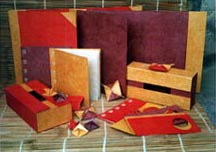 Traditional
Nepalese paper, popularly known as "rice paper", is actually
made of lokta or daphne bark found in remote areas of the country.
Many stores in Thamel and Patan sell writing pads and bound journals,
as well as calendars and lamp shades of lokta paper. Traditional
Nepalese paper, popularly known as "rice paper", is actually
made of lokta or daphne bark found in remote areas of the country.
Many stores in Thamel and Patan sell writing pads and bound journals,
as well as calendars and lamp shades of lokta paper.
For a look at some of the most exclusive paper
designs, spend an evening at Babar Mahal Revisit (a Rana Palace
fantastically restored as a shopping and dining complex.) There
you will find the creations of Marina - MarinaPaper.com
- in her Paper Moon showroom. Check out the playing cards on Nepali
paper and foldable lamp designs for easy transport back home - neat!
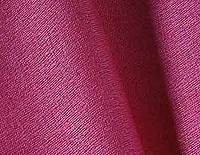 Pashmina,
from the Persian word for wool, is popularly known in the west as
cashmere wool, from the old spelling for Kashmir. The fine wool
comes from the undercoat of the Himalayan mountain goat, which lives
in the most remote regions of the Tibetan Plateau. For over a thousand
years cashmere has been woven into shawls and blankets, prized by
royalty and common people alike for its otherworldly softness, warmth,
and long life. Pashmina,
from the Persian word for wool, is popularly known in the west as
cashmere wool, from the old spelling for Kashmir. The fine wool
comes from the undercoat of the Himalayan mountain goat, which lives
in the most remote regions of the Tibetan Plateau. For over a thousand
years cashmere has been woven into shawls and blankets, prized by
royalty and common people alike for its otherworldly softness, warmth,
and long life.
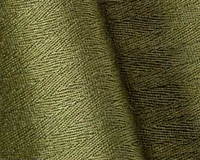 For
many centuries Kashmir was the only place the fiber could be woven
into shawls, according to treaties that gave the Maharaja of Kashmir
exclusive rights to Tibet's pashmina supply. Today most of the world's
pashmina shawls are woven on handlooms in Nepal's Kathmandu Valley.
And most are woven on a warp of spun silk for increased suppleness
and strength. In recent years this silk and cashmere blend has become
the darling of the western fashion world. For
many centuries Kashmir was the only place the fiber could be woven
into shawls, according to treaties that gave the Maharaja of Kashmir
exclusive rights to Tibet's pashmina supply. Today most of the world's
pashmina shawls are woven on handlooms in Nepal's Kathmandu Valley.
And most are woven on a warp of spun silk for increased suppleness
and strength. In recent years this silk and cashmere blend has become
the darling of the western fashion world.
Paubha. These traditional paintings
(thanka in Tibetan), depict deities and religious symbols from Buddhism.
Painted on cotton scrolls, the best paubhas are made using ground
stone pigments to create their vivid colors. Powdered silver and
gold are other key ingredients.
Pottery. Extremely proficient
in the delicate art of making both terra-cotta and glazed earthenware,
Kathmandu’s potters make various articles from the black clay
that abounds in the Valley. Their products range from household
utensils to inexpensive decorative souvenirs.
Spices. Since ancient times,
traders have followed their noses to the spice markets of Asia.
Kathmandu’s markets offer exotic ingredients to add flavor
to your curries — nutmeg, ginger, saffron, mace, anise, fenugreek,
black pepper, coriander seeds and other aromas.
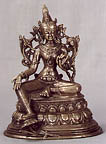 Statues.
The casting of bronze, brass and copper statuary in Nepal dates
back to the 13th century. Casters in Nepal use the ancient and labor
intensive "lost-wax method" in which ornate figures, modeled
in bees-wax and used to create the earthenware molds, are melted
away and "lost" prior to the actual casting. Statues.
The casting of bronze, brass and copper statuary in Nepal dates
back to the 13th century. Casters in Nepal use the ancient and labor
intensive "lost-wax method" in which ornate figures, modeled
in bees-wax and used to create the earthenware molds, are melted
away and "lost" prior to the actual casting.
Tea. Nepal’s eastern hilly
districts, notably Ilam, produce a variety of excellent tea, most
of which is exported. Kathmandu’s shops offer a wide selection
of fine Nepalese tea in attractive packaging which makes it suitable
as gifts.
Wood carving. The expertise of
Newar craftsmen in this field can be seen in the intricately carved
windows, doors, pillars and latticed art-works fitted in temples
throughout the Kathmandu Valley. Ornate doors and windows, picture
frames, jewelry boxes and furniture are produced in the workshops
of Patan and Bhaktapur.
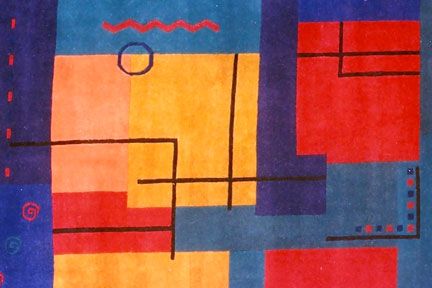 Woolen
carpets. Carpets made in Nepal are hand-knotted using the
traditional techniques of Tibet. The best of them are woven from
a mixture of the highland Himalayan sheep’s wool and New Zealand
long staple wool. Woolen
carpets. Carpets made in Nepal are hand-knotted using the
traditional techniques of Tibet. The best of them are woven from
a mixture of the highland Himalayan sheep’s wool and New Zealand
long staple wool.
|
|
related
topics
 |
|
other
topics viewed by visitors
 |
|
|

 The
craftsmen of the Kathmandu Valley were well respected at the royal
court of China in ancient times. The very same crafts which earned
them fame are practiced here today, side by side with their modern
brothers and sisters. To step into a Kathmandu Valley workshop is
to step back in time 400 years. And those items which you bring
home with you will forever link you to the days of exotic courts
and arduous trade routes.
The
craftsmen of the Kathmandu Valley were well respected at the royal
court of China in ancient times. The very same crafts which earned
them fame are practiced here today, side by side with their modern
brothers and sisters. To step into a Kathmandu Valley workshop is
to step back in time 400 years. And those items which you bring
home with you will forever link you to the days of exotic courts
and arduous trade routes.  Gems.
Kathmandu boasts one of the widest selections of loose gems in the
entire region, often at comparatively low prices. Many stones including
ruby, aquamarine, black and green tourmaline, quartz and "healing
stones" are mined in the high mountains of Nepal. Want to know
what stone is best for you? Diana, of
Gems.
Kathmandu boasts one of the widest selections of loose gems in the
entire region, often at comparatively low prices. Many stones including
ruby, aquamarine, black and green tourmaline, quartz and "healing
stones" are mined in the high mountains of Nepal. Want to know
what stone is best for you? Diana, of  Jewelry.
Apart from necklaces, bracelets, rings and the traditional silver
beads made especially in Patan, old Tibetan jewelry also abounds
in the markets of Kathmandu. A glass bead market tucked away near
Indra Chowk stocks colorful glass beads imported from all over the
world. Creation Nepal's
Jewelry.
Apart from necklaces, bracelets, rings and the traditional silver
beads made especially in Patan, old Tibetan jewelry also abounds
in the markets of Kathmandu. A glass bead market tucked away near
Indra Chowk stocks colorful glass beads imported from all over the
world. Creation Nepal's  Traditional
Nepalese paper, popularly known as "rice paper", is actually
made of lokta or daphne bark found in remote areas of the country.
Many stores in Thamel and Patan sell writing pads and bound journals,
as well as calendars and lamp shades of lokta paper.
Traditional
Nepalese paper, popularly known as "rice paper", is actually
made of lokta or daphne bark found in remote areas of the country.
Many stores in Thamel and Patan sell writing pads and bound journals,
as well as calendars and lamp shades of lokta paper. Pashmina,
from the Persian word for wool, is popularly known in the west as
cashmere wool, from the old spelling for Kashmir. The fine wool
comes from the undercoat of the Himalayan mountain goat, which lives
in the most remote regions of the Tibetan Plateau. For over a thousand
years cashmere has been woven into shawls and blankets, prized by
royalty and common people alike for its otherworldly softness, warmth,
and long life.
Pashmina,
from the Persian word for wool, is popularly known in the west as
cashmere wool, from the old spelling for Kashmir. The fine wool
comes from the undercoat of the Himalayan mountain goat, which lives
in the most remote regions of the Tibetan Plateau. For over a thousand
years cashmere has been woven into shawls and blankets, prized by
royalty and common people alike for its otherworldly softness, warmth,
and long life.  For
many centuries Kashmir was the only place the fiber could be woven
into shawls, according to treaties that gave the Maharaja of Kashmir
exclusive rights to Tibet's pashmina supply. Today most of the world's
pashmina shawls are woven on handlooms in Nepal's Kathmandu Valley.
And most are woven on a warp of spun silk for increased suppleness
and strength. In recent years this silk and cashmere blend has become
the darling of the western fashion world.
For
many centuries Kashmir was the only place the fiber could be woven
into shawls, according to treaties that gave the Maharaja of Kashmir
exclusive rights to Tibet's pashmina supply. Today most of the world's
pashmina shawls are woven on handlooms in Nepal's Kathmandu Valley.
And most are woven on a warp of spun silk for increased suppleness
and strength. In recent years this silk and cashmere blend has become
the darling of the western fashion world. Statues.
The casting of bronze, brass and copper statuary in Nepal dates
back to the 13th century. Casters in Nepal use the ancient and labor
intensive "lost-wax method" in which ornate figures, modeled
in bees-wax and used to create the earthenware molds, are melted
away and "lost" prior to the actual casting.
Statues.
The casting of bronze, brass and copper statuary in Nepal dates
back to the 13th century. Casters in Nepal use the ancient and labor
intensive "lost-wax method" in which ornate figures, modeled
in bees-wax and used to create the earthenware molds, are melted
away and "lost" prior to the actual casting.  Woolen
carpets. Carpets made in Nepal are hand-knotted using the
traditional techniques of Tibet. The best of them are woven from
a mixture of the highland Himalayan sheep’s wool and New Zealand
long staple wool.
Woolen
carpets. Carpets made in Nepal are hand-knotted using the
traditional techniques of Tibet. The best of them are woven from
a mixture of the highland Himalayan sheep’s wool and New Zealand
long staple wool.
